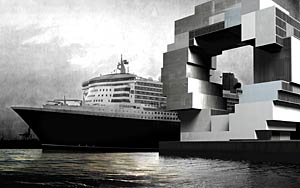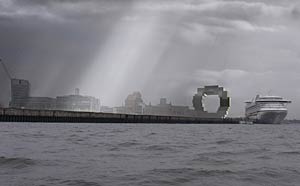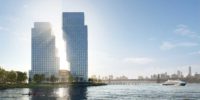Rem Koolhaas, the Dutch master of urban innovation and principal of the Office for Metropolitan Architecture (OMA), has unveiled plans to cap the reinvention of a German waterfront with an aquarium and science center. The project in Hamburg’s new HafenCity district aims to elevate street life while addressing the prospect of rising sea levels.


OMA’s design for the Hamburg Science Center calls for a structure composed of 10 modular concrete blocks arranged on a slip to resemble a colossal but motionless wheel—or a life preserver (top). The 253,000-square-foot building will contain 91,500 square feet of aquarium and water-themed exhibitions underground, while much of the above-ground space will be devoted to laboratories (above).
Encompassing 383 acres, HafenCity stands among the world’s most sweeping reinventions of an industrial port. It is being spearheaded by the city and a coalition of developers and businesses, which selected OMA to develop a master plan for the site in 2004. The aquarium and science center will occupy a cultural district that includes a concert hall designed by Herzog & de Meuron, a hotel and cruise ship terminal by Massimiliano Fuksas, and harbor-side landscaping by the Spanish designer Beth Gali.
OMA’s design aims to make the aquarium both a highlight of HafenCity’s skyline and a summation of its mission. It calls for a structure composed of 10 modular concrete blocks arranged on a slip to resemble a colossal but motionless wheel—or a life preserver. The 253,000-square-foot building will contain 91,500 square feet of aquarium and water-themed exhibitions underground, while much of the above-ground space will be devoted to laboratories. Its concrete skin will be covered in a glaze, the details of which are still being fine-tuned, to catch reflections of sunlight off the water. “The idea was not to have an enclosed glass box,” says project architect Marc Paulin. “This big stone arch doesn’t have to show off.”
Paulin adds that hole at the center of the building, which echoes OMA’s renowned CCTV tower design in Beijing, alludes to anxiety about climate change. HafenCity’s codes require high walls to be constructed along the harbor to protect against rising sea levels, yet the aquarium’s central hole allows views to the water and eases access to it. “We recognized that the waterfront is completely empty and people walking on it always have a wall at their backs,” Paulin explains. “Our building is like a shortcut. You can enter from the waterfront and go up 20 steps to a main plaza.”
Although this main plaza will contain a café, the aquarium’s gift shop will be located in the basement, underscoring the seriousness of the project. “We want to create a place for reality and not just a place to amuse children for a couple of hours,” Paulin says. But this basement space will be far from grim. The same level contains the aquarium, which will feature exhibits of marine life from the nearby Elbe River and the Red Sea. Construction is expected to begin by summer 2009 and finish by 2011. Neither the architect nor the developers are disclosing the cost.
In addition to the culture district, HafenCity’s other key elements include 5,500 new residential units, office space for 40,000 new jobs, and a new headquarters for Unilever. OMA’s master plan calls for a sustainable ethic that emphasizes paths for pedestrian rather than roadways cars. The entire development will be built out in phases through 2025.




Post a comment to this article
Report Abusive Comment